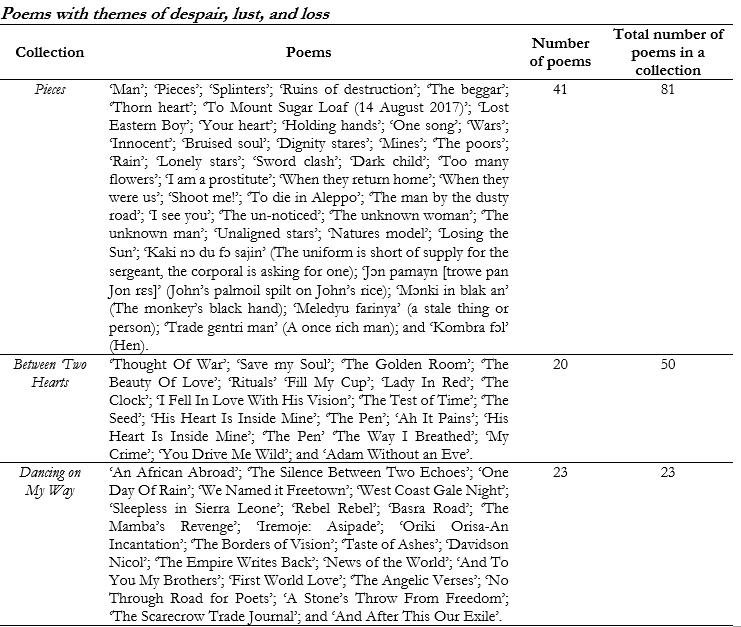Ideology in Thompson’s, Kailey’s, and Robbin-Coker’s collections of poems: A psychoanalytical exploration
DOI:
https://doi.org/10.33474/j-reall.v5i1.20586Keywords:
despair, loss, psychoanalysis, relationshipAbstract
This study employed psychoanalytic theory to delve into the ways Sierra Leonean poets Celia Eva Beatrice Thompson, Princess Mildred Kailey, and Kayode Adesimi Robbin-Coker explored themes of despair, lust, and loss in their poetry. Addressing a notable gap in literary criticism, especially regarding Sierra Leonean authors, the research sought to raise the international stature of African writers and support students facing challenges with poetry in West African public exams. Employing psychoanalytic principles, the study uncovered deeper meanings behind the unconscious drives and emotions in these poets' works. It involved analyzing the occurrence of themes, detecting psychoanalytically significant lines and phrases, and identifying central themes and literary techniques used to express complex emotions. The analysis, which combined thematic and literary analysis, focused on the language, themes, and use of figurative language, diction, and other poetic devices in Thompson’s 41, Kailey’s 20, and Robbin-Coker’s 23 poems. This approach highlighted their distinct ways of depicting despair, lust, and loss. By integrating thematic analysis, the study offered a more profound comprehension of each poet's style. Ultimately, this psychoanalytic exploration aimed to enhance critical interpretation skills and helped in understanding the deeper psychological aspects of Sierra Leonean and other African poetry.
References
Bano, S. (2020). Despondency of women as portrayed in Shashi Deshpande’s ‘That Long Silence’. Journal of Science and Innovative Technologies, 82.
Ellmann, M. (2014). Psychoanalytic literary criticism. Routledge.
Fitriani, Y. (2019). The analysis of psychological aspects of the main character in movie ‘Joker’ based on Sigmund Freud’s theory. Humanitatis: Journal of Language and Literature, 6(1), 119-128.
Fofanah, I. M., Thulla, P. F. Y., & Moriba, S. (2021). Practitioners and uses of contemporary Mende folk literature in south-eastern Sierra Leone. Academic Journal of Interdisciplinary Studies, 10(6), 97-97.
Fromm, E. (2013). Man for himself: An inquiry into the psychology of ethics. Routledge,102.
Frosh, S. (2008). For and against psychoanalysis. Routledge.
Holland, N. N. (2000). The mind and the book: a long look at psychoanalytic literary criticism. Journal of Applied Psychoanalytic Studies, 2(1), 13-23.
Hossain, M. M. (2017). Psychoanalytic theory used in English literature: A descriptive study. Global Journal of Human-Social Science: Linguistics & Education, 17(1), 41-46.
Huber, E. R. (2008). For Y am sorwe, and sorwe ys Y: Melancholy, despair, and pathology in Middle English literature. University of Rochester.
Hunter, E. (2018). Damned above ground: Dreadful despair in Elizabethan and Stuart literature. In fear in the medical and literary imagination, Medieval to Modern. Palgrave Macmillan, London. (pp. 157-175).
Kailey, P. M. I. N. (2019). Between two hearts. Sierra Leonean Writers Series.
Kanwar, M. G. (2014). Portrayal of love in literature. Research scholar, An International Refereed e-Journal of Literary Explorations, 2.
Robbin-Coker, K. A. (2019). Dancing on my way. Sierra Leonean Writers Series.
Khan, M. M. R. (2018). The privacy of the self: Papers on psychoanalytic theory and technique. International Universities Press.
Killingmo, B. (2007). Relational-oriented character analysis: A position in contemporary psychoanalysis. The Scandinavian Psychoanalytic Review, 30(2), 76-83.
Macherey, P. (2015). Theory of literary production. Routledge.
Niaz, A., Stanikzai, S. M., & Sahibzada, J. (2019). Review of Freud’s psychoanalysis approach to literary studies. American International Journal of Social Science Research, 4(2), 35-44.
Roccas, N. M. (2017). Time and despondency: Regaining the present in faith and life. Ancient Faith Publishing.
Rosenfeld, H. (2003). A clinical approach to the psychoanalytic theory of the life and death instincts. Melanie Klein Today, Volume 1: Mainly Theory: Developments in Theory and Practice, 7, 239.
Schaffner, A. K. (2016). Exhaustion: A history. Columbia University Press.
Sewall, R. B. (1994). The life of Emily Dickinson. Harvard University Press, 1.
Thompson, C. B. E. (2019). Pieces. Sierra Leone Writers Series.
Thulla, F. Y. P., Koroma, A., Moriba, S., & Fofanah, I. M. (2022). Folk media: Existence, forms, uses and challenges in Mende indigenous communities of Southern Sierra Leone. Research Journal in Advanced Humanities, 3(4), 13-25.
Thulla, P. F., & Fofanah, I. M. (2023). Constructivist referents in Oumar Farouk Sesay’s The song of the women of my land. Elsya: Journal of English Language Studies, 5(3).
Vidler, A. (2002). Warped space: Art, architecture, and anxiety in modern culture. MIT Press.
Wright, E. (2013). Psychoanalytic criticism. Routledge.
Zarieva, N. P., Iliev, K., Krsteva, M., & Donev, D. (2019). The origins of the seven deadly sins. Yearbook-Faculty of Philology, 10(14), 49-53.

Downloads
Published
How to Cite
Issue
Section
License
Copyright (c) 2023 Philip Foday Yamba Thulla, Ibrahim Mustapha Fofanah

This work is licensed under a Creative Commons Attribution 4.0 International License.
Authors who publish this journal agree to the following terms:
- Authors retain copyright and grant the journal right of first publication with the work simultaneously licensed under a Creative Commons Attribution License that allows others to share the work with an acknowledgement of the work's authorship and initial publication in this journal.
- Authors can separately make additional contractual arrangements for non-exclusive distribution published by the journal (e.g., publish it in a book), with an acknowledgement of its initial publication in this journal.
- Authors are allowed and encouraged to send their work via online (e.g., in the institutional repositories or their website) after published by the journal.





















